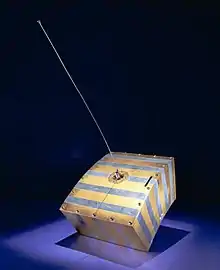Es'hail 2
Es'hail 2 is a Qatari satellite, launched aboard a SpaceX Falcon 9 rocket on November 15, 2018.[4][5] Es'hail 2 was built by Japan's Mitsubishi Electric company, and will operate at 26° East longitude along a geostationary orbit to provide direct-to-home television services in the Middle East and North Africa region.[6] The satellite will feature 24 Ku-band and 11 Ka-band transponders to provide direct broadcasting services for television, government and commercial content distribution.[7] In addition to commercial services, the payload of Es'hail 2 includes a linear transponder with a bandwidth of 250 kHz and 8MHz for the amateur radio satellite service, with uplink on 2.4 GHz (S band) and downlink on 10.45 GHz (X band). [8]
.jpg.webp) Launch of Falcon 9 flight 63 carrying Es'hail-2 | |
| Mission type | Communications |
|---|---|
| Operator | Es'hailSat |
| COSPAR ID | 2018-090A |
| SATCAT no. | 43700 |
| Mission duration | 15 years (planned) |
| Spacecraft properties | |
| Bus | DS2000 |
| Manufacturer | Mitsubishi Electric |
| Launch mass | 5,300 kilograms (11,700 lb) |
| Start of mission | |
| Launch date | 15 November 2018, 20:46 UTC |
| Rocket | Falcon 9 Full Thrust |
| Launch site | Kennedy LC-39A |
| Contractor | SpaceX |
| Orbital parameters | |
| Reference system | Geocentric |
| Regime | Geostationary |
| Longitude | 26° East[1] |
| Inclination | 0.033[2] |
| Epoch | 60[3] |
Amateur radio transponders
| Transponder | U/L FREQUENCY [MHz] | D/L FREQUENCY [MHz] | LO [MHz] | BW [MHz] | ||||||
|---|---|---|---|---|---|---|---|---|---|---|
| Pol | Begin | Center | End | Pol | Begin | Center | End | |||
| NB | RHCP | 2400,05 | 2400,175 | 2400,3 | V | 10489,55 | 10489,675 | 10489,8 | 8089,5 | 0,25 |
| WB | RHCP | 2401,5 | 2405,5 | 2409,5 | H | 10491 | 10495 | 10499 | 8089,5 | 8 |
| References: [9] | ||||||||||
"NB" Transponder (narrow band)
Linear Transponder for low power narrow bandwidth voice, morse and digital communication
- preferred modes: narrow band modes like SSB and CW, PSK
- 250 kHz allocated bandwidth
- non-inverting bent-pipe transponder
- Assumes 50 simultaneous 2-way carriers to serve 100 Users
- X-Band Downlink (SAT-TV dish):
- 90 cm dishes in rainy areas at EOC like Brazil or Thailand
- 60 cm around coverage peak
- 75 cm dishes at peak -2dB
- Downlink Polarisation on X-Band is Vertical !
- Uplink Polarisation on S-Band is RHCP
- Uplink transmitter 5-10W PEP (22.5 dBi antenna gain, 75cm dish)
The narrowband transponder is intended for conventional analogue and narrowband digital signals.
No transmissions should be made beyond the nominal edges of the transponder passbands. In particular, no operation should take place below the lower beacon nor above the upper beacon.
No uplinks should result in downlink signals that are stronger than these beacons. In the event that such signals are detected, they will be marked by a “LEILA” siren. When they have been marked by “LEILA”, operators should immediately reduce their uplink power (ERP).
No FM transmissions should be made to Es’hail-2 as these would use excessive power and bandwidth.
Although there is no formal bandplan, the following details are provided for initial guidance.
| Uplink [MHz] | Downlink [MHz] | available Bandwidth [kHz] | Notes |
|---|---|---|---|
| 10489,550 – 10489,555 | do not transmit | Lower Beacon, 400 Bit/s BPSK or CW | |
| 2400,055 – 2400,100 | 10489,555 – 10489,600 | 45 | CW Only |
| 2400,100 – 2400,120 | 10489,600 – 10489,620 | 20 | narrowband digimodes (500 Hz max. BW) |
| 2400,120 – 2400,140 | 10489,620 – 10489,640 | 20 | digimodes (2700 Hz max. BW) |
| 2400,140 – 2400,190 | 10489,640 – 10489,690 | 50 | mixed modes (2700 Hz max. BW) |
| 2400,190 – 2400,295 | 10489,640 – 10489,795 | 105 | SSB only |
| 10489,795 – 10489,800 | do not transmit | Upper Beacon, 400 Bit/s BPSK or CW |
"WB" Transponder (wide band)
Linear Transponder for Digital Amateur Television (DATV) and other highspeed data transmissions. First DATV transponder in space.
- 8 MHz bandwidth (3 MHz used by beacon)
- Uplink Polarisation on S-Band is RHCP
- Downlink Polarisation on X-Band is horizontal
- Beacon sending video from launch at 10.492500 GHz DVB-S2 QPSK 2MS FEC 2/3
- DVB-S2 is used as standard in all amateur transmissions
- 5 channels for 333 kS (500 kHz) transmissions, 2 channels for 1000 kS (or one 2000 kS)
- Typical amateur data streams are between 400 and 1200 kbit
- Internet spectrum monitor and chat for transmission coordination
- Receive equipment on downlink:
- 90 cm offset dish
- standard Ku-band LNB
- F6DZP MiniTiouner, Octagon SF4008 or SDR software decoders
- Uplink equipment:
- 120 cm dish (preferably larger)
- Minimum 30W of output power
- SDR (Adalm-Pluto, LimeSDR, BladeRF)
Amateur Radio Operators
Well over 130+ amateur radio operators have used the amateur radio transponder in the first few weeks of operation.[10]
See also
References
- https://amsat-dl.org/eshail-2-amsat-phase-4-a
- https://www.karhukoti.com/webtracker?s=43700
- https://www.karhukoti.com/webtracker?s=43700
- "SpaceX on Twitter". Twitter. Retrieved 2018-10-17.
- "SpaceX on Twitter". Twitter. Retrieved 2018-11-15.
- Clark, Stephen. "SpaceX selected for launch of Qatari satellite – Spaceflight Now". Retrieved 2016-03-28.
- "Es'hail-2 Communication Satellite". Retrieved 2019-01-06.
- ""Es'hail-2 Geostationary Satellite Carrying Amateur Radio Payload Launched"". American Radio Relay League. 2018-11-15.
- "Es'hail-2 / AMSAT Phase 4-A". Retrieved 2019-01-06.
- "Es'hail-2 QO-100 Callsign Log". Retrieved 2019-03-29.

